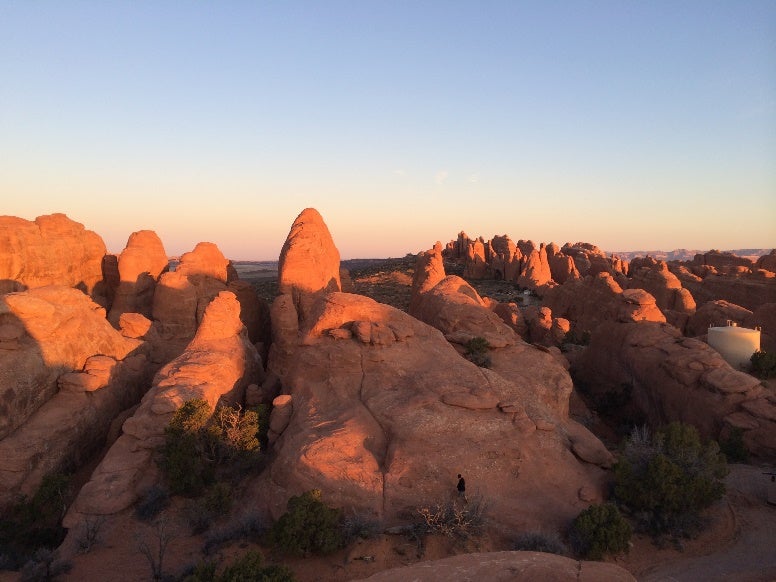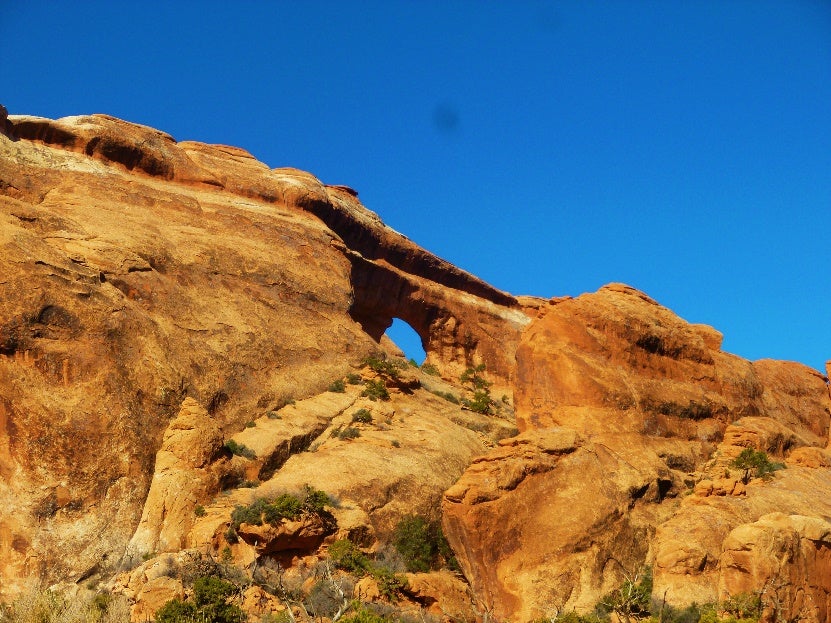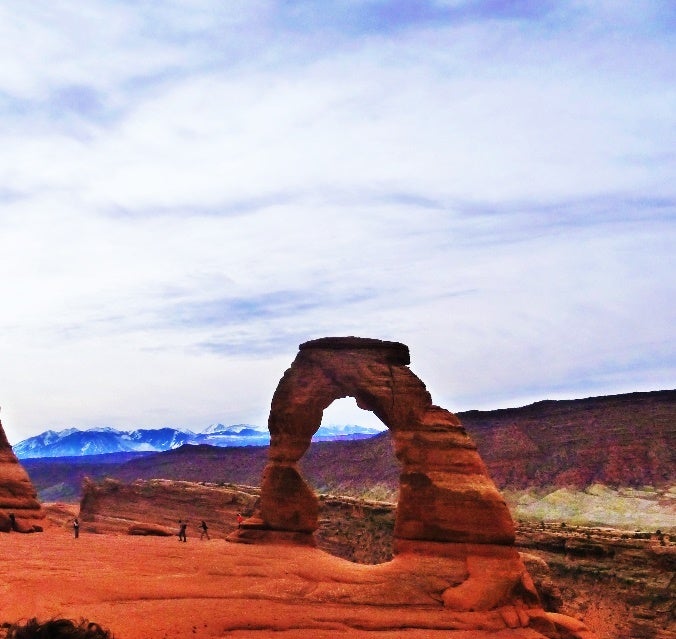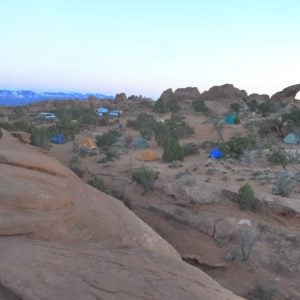Geology of Arches National Park
Anthony Scorsone and Michelle Zitzmann
Geologic Setting
Arches National Park is located on the Colorado Plateau in east-central Utah. This is the heart of the Pennsylvanian Paradox Basin, which was deposited around 315-307 million years ago. The park includes formations from the Early Jurassic Glen Canyon Group, and the Middle Jurassic San Rafael Group (Carmel Formation, 2010). The oldest unit in the park is the Navajo Sandstone, and the youngest is the Carmel Formation. The ages of these units range from about 208 Ma to 160 Ma (Navajo Sandstone, 2014).
Geologic History
The Paradox Salt Basin consists of evaporate deposits from the Pennsylvanian Epoch. Many sedimentary layers were deposited on top of this salt, including the Carmel, Entrada, and Navajo Sandstones, which comprise the park. The Colorado Plateau itself began to uplift in the Tertiary. Because the salt is significantly less dense than the surrounding rock, it began to rise during the Late Tertiary to Early Quaternary. This caused the overlying sedimentary rock to fracture and deform. Over time, the up-welled salt caught in fractures between the sandstone began to erode and eventually disappeared completely. This left behind similarly oriented sandstone “fins” that are seen in Arches National Park today. The jointing and fractures in the sandstone also gave way to the formation of arches and windows. Wind-blown sand grains combined with frost wedging wears away at these fractures and eventually breaks through the sandstone to form a window. As this process continues, arches will develop as the windows grow (Doelling, 2000).
Geologic Formations
Carmel Formation: The Carmel Formation is a mix of siltstone, mudstone, and sandstone that was deposited in the Middle to Late Jurassic. The formation was deposited during several transgressive-regressive sequences in a marginal marine setting (Richards, 1958). This formation is present in the youngest parts of the park and is not widely seen.
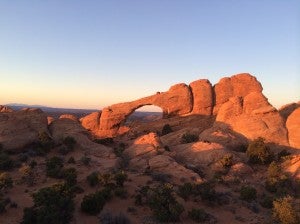
Entrada Sandstone: The Entrada Sandstone is an aeolian sandstone deposited during the Middle to Late Jurassic. It is cross-stratified throughout, with large scale slip faces easily discernable from a distance. This deposit is the result of an ancient erg, or sand sea. The sandstone is a light yellow-orange in color and is supermature. All of the fins and arches found in the Park consist of this sandstone (O’Sullivan, 2003).
Navajo Sandstone: The Navajo Sandstone is also an aeolian-deposited sandstone, of Middle Jurassic age. It is also cross-stratified and supermature. Like the Entrada, the Navajo sandstone is the result of an ancient erg. However, unlike the Entrada, the Navajo has a distinct pink-to-red coloring, the result of iron oxides in a reducing environment that occurred post-deposition. The Navajo Sandstone makes up the base of the park and is largely not seen (Navajo, 2014).
The fins seen in Arches National Park were formed by the upwelling of the Paradox Salt Formation. These massive features formed as the Paradox Formation ascended through less dense bedrock. It began to fracture the Navajo and Entrada Sandstones, which resulted in jointing at the points of least resistance. Typically, in aeolian sandstone, this would occur at the slip-faces, bedding planes, and between sets. However, it would seem that the sandstone in Arches National Park has been homogeneously cemented resulting in a lack of typical weaknesses. Therefore, the fractures did not occur along the fabric of the rock. Instead, this led to vertical jointing that oriented the fins perpendicular to the applied regional stress.
Windows
Windows
Windows are the precursor to arches, and are the result of wind and water erosion taking place in the fractures of the rock. Water is a major erosional agent in this case, as frost wedging greatly deteriorates the rock. Sand grains suspended in the wind will also hollow out the rock and give it a rounded surface. Eventually, these combined forces will wear away the sandstone until a window is formed (Cruikshank, et. al., 1994).
Delicate Arch: Formed at contact between the Entrada and Curtis (between Morrison and Entrada) Formations, this beautiful example of wind and water erosion exists as a testament of time (Doelling, 2000).
Personal Impressions
Arches National Park was our favorite park of the trip. Not only does it have amazing views and fascinating geologic features, but it also has an excellent campground with plenty to explore. We all turned into mountain goats our first night. The campground is in the middle of the fins and is more like a playground than a campsite. The stars at night are breathtaking, and the sunsets/sunrises were incredible on the red sandstones. Moab, however, does not look quite as appealing as the campground, but it still holds some entertainment value.
- Morgan Haldeman showing off her incredible climbing abilities.
- Anthony Scorsone with our campsite in the background.
References Cited
Carmel Formation, 2010, The University of Utah. Retrieved, from http://sed.utah.edu/Carmel.htm
Cruikshank, K.M, Aydin, A., 1994, Role of fracture localization in arch formation, Arches National Park, Utah: Geological Society of America Bulletin, v.106, no. 7, p. 879-891.
Doelling, H. H, 2000, Geologic road and trail guides to Arches National Park, utah. Utah Geological Survey.
Navajo Sandstone, 2014, National Parks Service. Retrieved, from http://www.nps.gov/cany/naturescience/navajo.htm
O’Sullivan, Robert B., 2003, The Middle Jurassic Entrada Sandstone in Northeastern Arizona and adjacent areas. New Mexico Geological Society Guidebook, 54th Field Conference, p. 303-308.
Richards, H. G., 1958, Cyclic deposition in the Jurassic Carmel Formation of eastern Utah: Journal of Sedimentary Petrology, v. 28, no. 1, p. 40-45.
 Home
Home Browse
Browse Close
Close Events
Events Maps
Maps Email
Email Brightspace
Brightspace eCampus
eCampus



